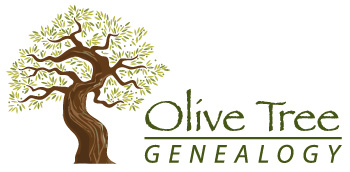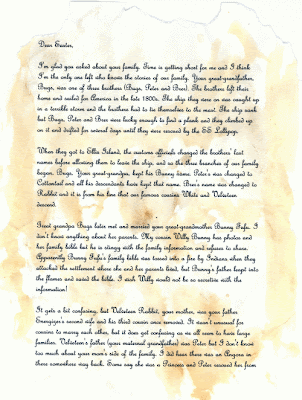My Grandmother died in January 1985. She was cremated and then interred in Guelph Ontario (or so I thought until yesterday). I had actually thought she was buried in Owen Sound which is where she died. I know - as a genealogist you'd think I would have known for sure but I made an assumption.
In early 1985 I was quite ill and eventually had an operation, so when my grandmother died I was, to say the least, distracted. My mother and her older sister (Grandma's two eldest daughters) were in Florida and so their youngest sister, who lived in Owen Sound, handled all the arrangements. She (the youngest sister, my aunt) told me just last month that Grandma was actually buried with her first husband in Guelph, in the plot where my mother and father's ashes are being interred this week. Auntie said that she and her husband had a bronze plaque made for Grandma and it was attached to the tombstone.
I had a plaque made for my mom and dad and the cemetery placed it on the tombstone so my brother drove up to see it on the weekend. I asked him to have a look at Grandma's plaque and take a picture for me. On Saturday he phoned me from the cemetery to say "There's no plaque here except the one for mom and dad!" I was dumfounded but thought perhaps Auntie hadn't had a plaque done at all, or maybe Grandma was buried with one of her other husbands (she was married three times). So I phoned the cemetery but to my dismay they said Grandma was not in that plot with Grandpa. Nor was she anywhere in the cemetery under any name.
This was quite upsetting, as Auntie, although she is 86, is sharp as a tack. I doubted she would be confused over where her mother's ashes were placed! I phoned my older sister to ask what she remembered of Grandma's death, and had she gone to a service for her. I figured a service would have been held wherever Grandma was interred. But sis had moved that year to another province and so she knew very little. So I phoned my older brother but all he could recall was that yes, a service had been held but for some reason he'd been unable to go so didn't know where it took place.
After some thought, I called auntie and casually asked her if I was mixed up about Grandma's resting place, as there was no plaque on Grandpa's tombstone. No, she said, Grandma was laid to rest with her father (Grandma's first husband) and the family had gone to a graveside service. I was not going to tell her that her mother was missing so I tried to casually get more details from her. What emerged is very puzzling and I am hoping by writing about it here, readers might have some ideas for me on what I should or could do next.
Auntie said that when Grandma died, she and her husband (my uncle) were in Cuba and so their oldest son had to take care of things until they returned in March. Auntie said the ashes were kept by the Funeral Home (she couldn't recall the name) until March - but very unwillingly. Apparently the Funeral Home wanted to be paid for the cremation and storage of ashes as they said they didn't normally keep ashes and they wanted them out. But Auntie said Uncle couldn't pay until they came back in March and please be patient.
After their return home in March, Auntie said arrangements were made to have Grandma interred in Guelph and a plaque made. This is where it gets fuzzy as I could not ask WHO made the arrangements and HOW the ashes got to Guelph, without arousing Auntie's suspicions.
My next call was to her oldest son, my cousin. He said that all he was responsible for was clearing out Grandma's room in the Old Age Home where she was living. He had no money to pay the Funeral Home and knew his father would pay in March so he had no dealings with them (the Funeral Home) He did not know about a service, for some reason he had not attended. But he supported my belief that his mother (my aunt) is not confused, she's sharp as a tack and if she says her mother was to be buried in Guelph with her first husband, then that is what she was told.
I can't think of anyone else in the family I can ask. My mother and her sister are gone now, and they were not home from Florida in time for a service held in March/April anyway. My other cousins (Grandma's grandchildren) are either estranged from the family, in nursing homes themselves, or simply unavailable. My uncle, who would have paid the Funeral Home, is also deceased.
My plan is to phone every Funeral Home in Owen Sound and ask if they handled arrangements for my grandmother in January 1985. But that's a slim hope, the Funeral Home may not even be in existence any more. However I don't know what to do next.
I have to wonder if Uncle simply disposed of the ashes and told his wife (my aunt) that he'd had her mother interred in Guelph. If Auntie didn't actually witness the interment, she would have had no way of knowing that the ashes were not there when they held the service. And yes, that is something that Uncle might very well have done.
My second thought is that Uncle paid the Funeral Home bill, refused to take the ashes, and the Funeral Home disposed of them. Is that legal? I suspose a Funeral Home has to have some way of properly disposing of ashes that family members don't pick up. Or would the Funeral Home simply have kept the ashes for these past 24 years?? I kind of doubt it but I'm hoping that is what happened
My third thought is that the Funeral Home pulled a fast one, and told the family that they had arranged interment in Guelph, but never did. That's a tough one to swallow as there could be huge legal problems for them if they had been found out so I'm not really sold on that scenario!
Auntie did say that the Funeral Home manager was "quite horrible" and that he kept after them in February and first of March for his money and for someone to pick up Grandma's ashes, even though Uncle kept saying that he had no way to get the money to them while he was in Cuba.
So this is my question to readers of my blog - what do I do now? How do I find out what happened to my beloved Grandmother? And what do I tell Auntie? I don't want to tell her that her mother is missing. I also don't want to tell her that there's a chance her husband lied to her about her mother's interment! She knows there is no plaque (I knew she would see there wasn't one at the Memorial for my mom and dad in May, and I didn't want her to have that upset as well as just the normal emotions around burying her sister!) and while she's puzzled, she's not too upset (yet).
My sister thinks we should have a new plaque made and installed on the tombstone even though Grandma is not there, but I have a feeling the Cemetery won't allow that, as we just had mom and dad's plaque installed on that tombstone.
Any ideas for me? I'm very distressed by Grandma's disappearance as she always talked about how she would be laid to rest "With Charlie" her first husband, and how much that meant to her.

















